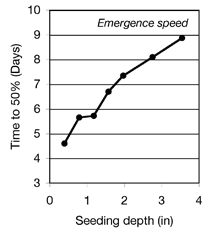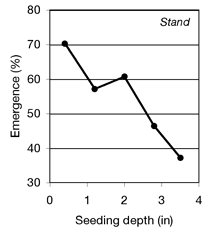Northeast Buckwheat Growers Newsletter
No. 23 June 2007
Edited by Thomas Bjorkman, Cornell NYSAES, Geneva NY
- Field Day on August 28, 2007
- Seed and grain prices rise
- Production notes
- Preston County Buckwheat Festival
- Canadian buckwheat production
- Research news
- Avoiding contamination
Field Day on August 28, 2007
The thirteenth annual Northeast Buckwheat Field Day will held August 28, 2007 in Geneva, NY from 1:00 to 3:30 pm.
This year’s field day will be at the New York State Agricultural Experiment Station research farm, the same venue as in 2006. The Experiment Station is celebrating its 125th year!
One demonstration will show the effect of varying the seeding date. We have seen differences in the duration of flowering, and in plant size in the past. A demonstration of field preparation will show the performance of no-till, as well as time between incorporation of crop residue and sowing buckwheat.
The research farm is at 1097 County Road 4, about a mile west of the Geneva Experiment Station towards Seneca Castle.
Seed and grain prices rise
For Birkett Mills, the 2007 price for growers is $2 higher than 2006 and continues a significant rising trend over several years. The 2007 contract rate is $15/cwt, and organic is $17 with a 50 acre minimum. The contracts specify Koto seeds, which costs $20 per 50 lb bag, or $22 for organic seed.
Cover crop seed is also available, with no variety specified. The cost for that is $19, or $22 for organic.
AgriCulver is selling Large-seeded or Forage buckwheat for $27 per bag, with a discount for large quantities. Ernst Conservation Seed in Meadville, PA lists cover crop buckwheat for $15 per bushel this year.
Cliff Orr of Birkett Mills reports that buckwheat flour demand is up for use in multigrain bread and the latest fast-food product, multigrain chips. You will see buckwheat listed on these chips from the major processors, and chances are good that it was grown here.
Production notes
In doing trials with buckwheat for cover crops in the last two years, I have had the chance to see plantings fail when we try things that a grain producer shouldn’t. One thing has become very clear. Hard ground does not let buckwheat thrive. We have encountered hard ground mainly where the soil has been over-worked and no longer supports enough aggregates. For the most part, buckwheat growers don’t have the time to work the ground so much that it gets in that state. However, it can happen if the soil is too wet or too dry when it is worked. One of the great advantages of the relatively late planting date for buckwheat is that there is more chance to prepare the ground on a day when the soil is just right. Buckwheat will help hold that tilth for the next crop as well.
The late planting date also creates some potential for double cropping. No-till farmers can put buckwheat after wheat, at least in warmer areas, because the ground is not too hard. However, conventionally tilled ground may be too hard and dry for buckwheat to grow well. We found that no-till planting after peas does not work because the ground is much too hard for successful establishment.
Preston County Buckwheat Festival
The Preston County Buckwheat Festival will be Sept. 27-30, 2007 in Kingwood, West Virginia. The web site for the festival won an award last year. The West Virginia Association of Fairs and Festivals honored it with the first-place Communications Award in the Web site category. You can find out about the biggest buckwheat festival in the US at their website, www.buckwheatfest.com.
The schedule is already in place, including animal judging, car show, firemen’s parade, fireworks, an appearance by Gov. Manchin and, of course, buckwheat pancakes. Chuck Miller is the general chairman and Jonathan Mauldin has the honorable title of King Buckwheat LXVI!
Canadian buckwheat production
Buckwheat production in Canada has been declining substantially in the last few years. 2004 was a terrible washout, which depressed average yields. Two respectable crop years followed, but the planted area dropped by 25-30%.
| Crop Year | 2003 | 2004 | 2005 | 2007 | 2007 (F) |
| Seeded Area (1000 ha) | 9 | 9 | 7 | 6 | 5 |
| Yield (t/ha) | 1.11 | 0.71 | 1.33 | 1.17 | 1.00 |
| Production (1000 tons) | 10 | 5 | 8 | 7 | 5 |
| Average Price ($C/ton) | 355 | 355 | 355 | 355 | 350-380 |
Source: Statistics Canada March 12, 2007
For 2007-08, Stan Skrypetz of Agriculture and AgriFood Canada forecasts that the area seeded to buckwheat will decrease further because of good prices for other crops. The average price is expected to increase because of the lower supply. Production is expected to be half of what it was in 2003. The forecast area for all of Canada is only about 12,000 acres.
Research news
Many growers ask about planting depth. We did a greenhouse study in field soil to find out how planting depth affects the time to emergence and the final stand. Rapid emergence is how buckwheat gets ahead of weeds, so five days is the goal. A good gap-free stand is important. The basis for the 50 lb/ac recommended seeding rate is that 2/3 of the seeds make strong plants.
The data suggest planting no deeper than an inch. Shallower seeding is good in excellent soil conditions that allow it. In the field, seeds that are too shallow may be lost because it is too dry, because they are exposed to air, or because they are eaten by birds. Deeper planting may be necessary if there is not moisture in the top, but the crop will not do as well. Soil preparation that brings moisture closer to the surface allows shallower sowing and faster emergence.
 |
 |
|
| The deeper the seed is planted, the slower it comes up. Emergence in 5 days is a good goal. | Deeper planting reduces emergence. Seeding below an inch may cause thin stands. |
Another issue to consider with planting depth is the risk of waterlogging during germination. The most common cause of lost stands of buckwheat is seed rot. Usually the seeds rot because the seed zone soil is saturated with water for a few hours in the days after seeding. The seed should be at a depth where water can percolate quickly. Silty soils often form a wet crust at the surface after a hard rain. The seed needs to be below the crust. Soils with a plow or disk pan get a waterlogged zone a few inches deep. Based on your knowledge of the soil, estimate the depth that will drain quickly after a thunderstorm. Good soil management makes the good zone bigger.
Avoiding contamination
In 2006, an Australian company ran into an export problem with pesticide contamination in their buckwheat. Japanese buyers rejected a load when they found a pesticide that exceeded the new Japanese limits (though not US limits). The event stopped buckwheat exports to Japan for a while, causing trouble for many buckwheat growers. It turns out the problem arose from some simple miscommunication on the farm. Geoff Brown of Buckwheat Enterprises Pty Ltd. kindly offered Northeastern buckwheat growers some advice on avoiding a similar situation.
First, check labels before applying a pesticide. In Australia, a new buckwheat grower’s employee used a familiar insecticide, dimethoate, to control a familiar insect long before harvest. He did not check the label to learn that it wasn’t to be used on buckwheat. This is the residue that was detected.
Second, the contaminant need not be applied to the crop. A second insecticide residue was also high enough to reject the load in Japan. It came from a chlorpyrifos application to an earlier crop, but there was enough left to leave a residue on the buckwheat. Chlorpyrifos is a pesticide that has been under particular scrutiny lately. If you are using up the remaining stocks of a pesticide like chlorpyrifos where some registered uses have been cancelled, check to see whether it is persistent and can show up in later buckwheat crops. If you are raising buckwheat for export, such pesticide use could be a decision factor in selecting fields. With materials like chlorpyrifos, spray drift, treated storage, and handling equipment can also potentially cause residues to reach the Japanese limits. Mr. Brown pencils out the limit at a quarter teaspoon material in 100 tons of grain.
Third, contamination need not be pesticides. Mr. Brown notes that they get tested for aflatoxin as well. In 2005, some Chinese buckwheat was rejected by Japanese buyers for this contaminant. Aflatoxin from mold is a big concern for Northeastern wheat growers. While this mold has not been reported on buckwheat, we really don’t know much about the potential.

